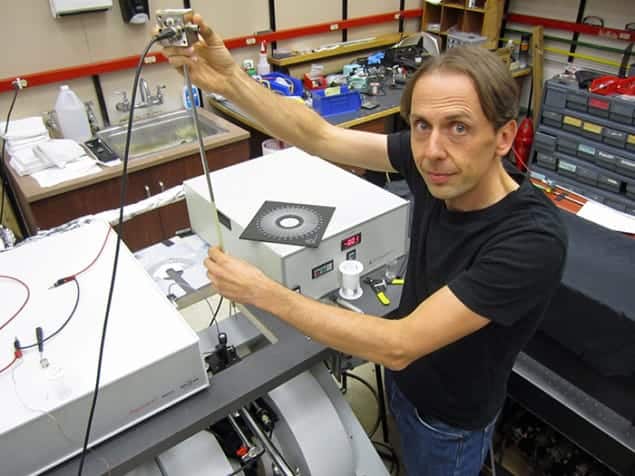
An international team of physicists has shown that information stored in the nuclear spins of hydrogen isotopes in an organic LED (OLED) can be read out by measuring the electrical current through the device. Unlike previous schemes that only work at ultracold temperatures, this is the first to operate at room temperature, and therefore could be used to create extremely dense and highly energy-efficient memory devices.
With the growing demand for ever smaller, more powerful electronic devices, physicists are trying to develop more efficient semiconductors and higher-density data-storage devices. Motivated by the fact that traditional silicon semiconductors are susceptible to significant energy losses via waste heat, scientists are investigating the use of organic semiconductors. These are organic thin films placed between two conductors and they promise to be more energy efficient than silicon semiconductors. Furthermore, the availability of many different types of organic thin film could help physicists to optimize the efficiency of these devices.
Chip and spin
Conventional memory chips store data in the form of electrical charge. Moving this charge around the chip generates a lot of waste heat that must be dissipated, which makes it difficult to miniaturize components and also reduces battery life. An alternative approach is to store information in the spins of electrons or atomic nuclei – with spin-up corresponding to “1” and spin-down to “0”, for example. This could result in memories that are much denser and more energy efficient than the devices used today.
Atomic nuclei are particularly attractive for storing data because their spins tend to be well shielded from the surrounding environment. This means that they could achieve storage times of several minutes, which is billions of times longer than is possible with electrons. The challenge, however, is how to read and write data to these tiny elements.
Now, Christoph Boehme and colleagues at the University of Utah, along with John Lupton of the University of Regensburg and researchers at the University of Queensland, have shown that the flow of electrical current in an OLED can be modulated by controlling the spins of hydrogen isotopes in the device. “Electrical current in an organic semiconductor device is strongly influenced by the nuclear spins of hydrogen, which is abundant in organic materials,” explains Lupton. The team has shown that the current flowing through a plastic polymer OLED can be tuned precisely, suggesting that inexpensive OLEDs can be used as efficient semiconductors.
Just like MRI
Boehme and his team applied a small magnetic field to their test OLED, which creates an energy difference between the orientations of the nuclear spins of protons and deuterium (both hydrogen isotopes). The researchers then used radio-frequency signals to alter the directions of the spins of the protons and deuterium nuclei – a process that is also done during a nuclear magnetic resonance (NMR) experiment.
The changes to the nuclear spins affect the spins of nearby electrons, and this results in changes to the electrical current. The magnetic forces between the nuclear and electron spins are millions of times smaller than the electrical forces needed to cause a similar change in current. This suggests that the effect could be used to create energy-efficient semiconductor memories.
This recent work follows on from research done in 2010, when Boehme and colleagues showed that the technique could be used to control current in a device made from phosphorus-doped silicon. However, this was only possible in the presence of strong magnetic fields and at temperatures within a few degrees of absolute zero. Such conditions are impractical for commercial devices, but the OLED-based device needs neither ultracold temperatures nor high magnetic fields.
Time to relax
“In organic semiconductors, the spin-relaxation time does not change significantly with temperature,” explains Lupton. “In contrast, the spin-relaxation time in phosphorus-doped silicon increases significantly when the temperature is lowered; so in phosphorus-doped silicon, the experiments had to be carried out at low temperatures and high magnetic fields.”
The team believes that its technique should also work with other nuclei with non-zero spin, with some limitations. “Since protons and deuterium are both hydrogen isotopes, they can be interchanged in the synthesis without changing the chemical structure of the polymer, which may not be possible with other types of nuclei,” Lupton explains. “Tritium, the third hydrogen isotope, is radioactive, so would not be much good in experiments.”
The research is described in Science.



